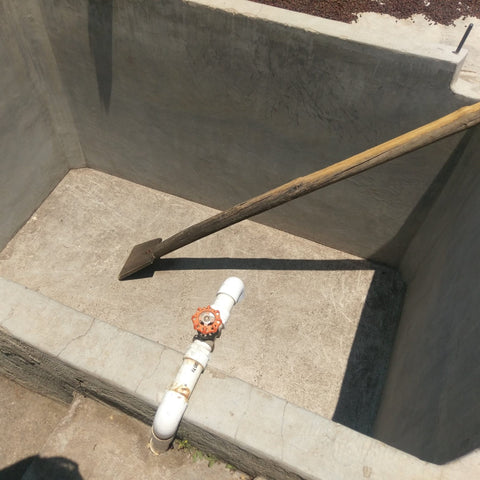
Coffee Origin Trip - Day 2: Chiapas, Mexico
Let's recap...What is a coffee origin trip?
Traveling to a coffee producing country is what the coffee industry refers to as an ‘origin trip.’ Due to the fact that the climate and elevation in the continental United States is not conducive to coffee growth, this travel is often necessary in understanding where our coffee comes from and is an important experience from the largest importers down to the smallest micro-roasters.
As a coffee roaster traveling to origin, we can expand our perspective in terms of not just production but of an entire region’s growing process from fertilizer to labor to the fully milled, exportable bean. It allows for a closer relationship with both producers and importers as well as a much more transparent connection with the coffee itself. At Water Street, we understand that our roaster is part of a larger global coffee community and the education we receive at origin is invaluable to being a responsible, contributing member of that community from knowing the issues that threaten the crops to seeing first hand the care and quality control that goes into each bag of coffee. So please, join us as we share how we tasted, hiked, and learned our way through some incredible coffee co-ops in Chiapas, Mexico.
DAY 2 - April 4, 2017
The drive to the first destination on our second day was a trying one. Following twisty, winding, bumpy roads up the mountains for about an hour and a half, we finally arrived at Ojo de Agua in the early afternoon. Located in the municipality of Montecristo, this farm (or finca) has been a member of CESMACH for 3 years, certified organic for 14 years, covers 9 hectares, and consists of 9 members, who all live on the farm.
The drying patios and wet mill, pictured below, lie about 50m below the plantation at 1500m above sea level.
 |
 |
| The Patios at Ojo de Agua Drying a Naturally Processed Coffee | The Main Fermentation Tank |
The hike up the mountain to the plantation was exciting and exhausting at an altitude of 1550m. We followed extremely narrow paths up the mountainside and first stopped at one of the nurseries the farm had on the path to the plantation.
 |
| Ojo de Agua’s Nursery |
Just past the nursery was the plantation with coffee plants scattered about the mountainside in such a way that if you didn’t know what to look for it was hard to distinguish them from the local flora. This, in particular, is where the devastating effects that rust has had began to truly sink in for us. Although the farm was producing well, there were still many trees that needed to be renovated and were completely unable to bear any fruit. It was sad to see but, despite the hardship, each and every person we had met thus far showed such hope and determination. And even better, their inspiring efforts to recover were starting to make a noticeable difference. Last year the farm produced 5,700kg of green coffee, this year it produced 11,000kg.
Another important aid in fighting the coffee rust, outside of the overwhelmingly positive morale, is the fact that Ojo de Agua uses the fertilizer and plants produced by CESMACH. This is a great example of how co-ops are essential to the success and survival of many coffee farms in Mexico. Without these invaluable resources many farms would have taken much longer to reach these levels of recovery on their own - if they were ever able to recover at all.
Although harvesting had finished at the time we visited, there were still some ripe cherries on a few trees which was one of the most exciting parts of the trip for me. Holding and tasting fresh coffee cherries was a delightful experience you can only get at origin. I popped one in my mouth and could tell from the size of the bean that it was the Maragogype varietal, a varietal on the farm that tends to yield larger beans. The taste was not too sweet and reminiscent of a cranberry or a grape.
 |
 |
 |
| A Healthy Coffee Plant | A Coffee Plant Affected by Coffee Rust | A Handful of Coffee Cherries |
To end our exploration of the farm, we were given a tour on how the farm wet-mills it’s coffee. After the coffee is brought down from the mountainside, it enters a washing tank, where floaters (any coffee beans that float) are removed as they are of lesser quality. After the initial soak, the coffee runs through a de-pulper which removes the skin and pulp of the coffee cherries. Once the pulp is removed, the coffee enters a fermentation tank where the beans are rinsed twice over a 24 hour period. This is where the remaining mucilage is washed off. Lastly, there is one more section of the washing station where the coffee is checked again for floating beans, which are removed, and then the coffee is channeled down to the patios for drying.
 |
| The Water Street Duo With Fresh Coffee Cherries in Hand |
The lasting impression from Ojo de Agua was that the farm had a very impressive, efficient setup. It’s clear how much care is taken in producing their coffee and that care shows through in the strides they have made to overcome the rust outbreak as well as the hospitality we were shown everywhere we went. Before our departure we were treated to lunch and a cup of coffee, a natural Maragogype grown right there on the farm. It doesn’t get any fresher than that!
Our second day ended back with CESMACH who shared their thanks and hospitality with us through a fantastic meal, cooked on site at the co-op, live music and all, for a true origin life experience.
Go back to Day 1...



